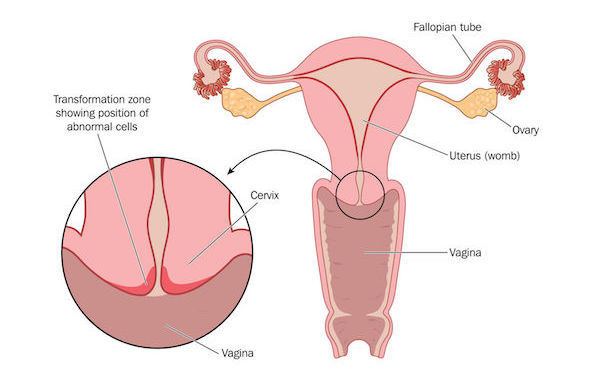According to the Cancer Association of South Africa (CANSA), one in 42 South African women have a lifetime risk of developing cervical cancer.

With regards to cervical cancer causes, it is estimated that 70% of cervical cancer is caused by HPV (human papillomavirus) infection through sexual contact with an infected individual.
Other risk factors include:
- Smoking
- A weakened immune system
- Having sex at an early age
- Having multiple sexual partners
- Sexually transmitted disease (STD) infections
- Certain genetic factors
What are its symptoms?
Cervical cancer may present with little to no symptoms in its early stages, which is why annual cervical cancer screening, that is, Pap smears, are recommended for sexually active women or those over the age of 21 (or no later than three years after a female has become sexually active).
Cervical cancer symptoms may include the following:
- Abnormal vaginal bleeding, that is, in between periods
- Bleeding after intercourse
- Discomfort during intercourse
- Pelvic pain
- Blood in vaginal discharge
- Odorous vaginal discharge
- Vaginal bleeding in post-menopausal women
How is it diagnosed?
A cervical cancer diagnosis involves tests to detect the presence of abnormal cells in the cervix.
These include:
- Cervical screening (Pap smear or liquid-based cytology test) – a tissue sample is taken from the cervix and tested under a microscope.
- Pelvic examination – often done in conjunction with the cervical screening, the doctor examines the vagina, uterus, ovaries, bladder, Fallopian tubes and rectum.
- HPV test – to detect the presence of HPV (HPV-16 and -18 strains are more common in women with cervical cancer).
- Colposcopy – an instrument called a colposcope is used to light up and magnify the cells of the vagina and cervix (this procedure is non-invasive).
- Biopsy – a biopsy involves the removal of a small amount of tissue for analysis by a pathologist. Depending on the type of biopsy, a local or general anaesthetic will be administered, and it may be performed in the doctor’s rooms or a hospital.
What are your treatment options?
Cervical cancer treatment will depend on the outcome of the tests that have been performed and whether the cancer is in its early stages or more advanced.
Treatment may be discussed with a gynaecological oncologist and include:
- Laser surgery – laser is used to destroy cancerous or precancerous cells.
- Hysterectomy – a full hysterectomy including the removal of pelvic lymph nodes.
- Radiation therapy – may be used to shrink tumours before surgery, and after surgery to reduce the risk of recurrence.
- Chemotherapy – may be used to reduce the size of the tumour.
For more advanced-stage cervical cancer, radiation and chemotherapy may be used in conjunction with each other.
Can it be prevented?
Cervical cancer prevention is possible, and if detected early enough, can be effectively treated. Follow this advice:
- Avoid HPV infection by practicing safe sex.
- Abstain from smoking.
- Begin cervical cancer screening from age 21, then at least every three years thereafter.
- From age 30 onwards have cervical screening and an HPV test (your healthcare professional or gynaecologist can advise how regularly these tests should be done depending on your health profile).
- Two HPV vaccines have been registered in South Africa. These should ideally be administered to girls aged 10 and 11, but can also be given up to age 18 as a ‘catch-up’ vaccine. For more information, read more here.
For more info
Cancer Association of South Africa
IMAGE CREDIT: 123rf.com
